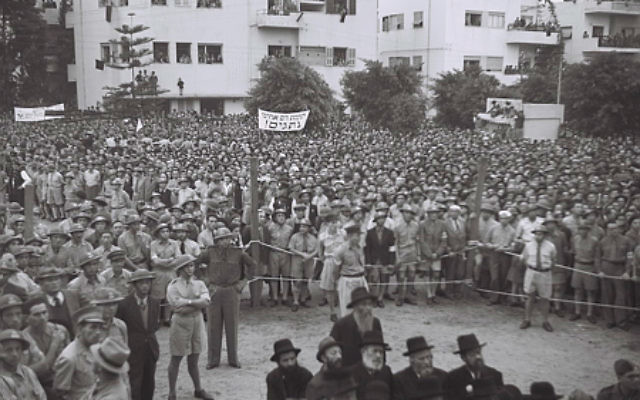Yom HaShoah: The Path to Memorialization

By Rich Walter
Seventy-four years ago this week, on Nov. 22, 1942, the Jewish Agency Executive met to discuss the situation facing Jewish communities in Europe. Word of Nazi extermination had recently reached Palestine, and the press would soon publish details of deportations and mass shootings.
The leadership proposed a national three-day period of mourning and prayer.
 In addition to the civil leadership, the chief rabbinate marked a religious response to the crisis. As part of the three days of mourning, it declared a fast on the third day with the sounding of the shofar.
In addition to the civil leadership, the chief rabbinate marked a religious response to the crisis. As part of the three days of mourning, it declared a fast on the third day with the sounding of the shofar.
Opposition to the fast arose from some religious leaders, who referenced a dirge recited on Tisha B’Av (the 9th of Av, on which we remember the destruction of the two Temples in Jerusalem). The dirge marks the destruction of three German Jewish communities during the Crusades.
While the communities were not destroyed on the 9th of Av, this prayer states, “The deaths of the Torah leaders (in the Crusades) was as worthy of mourning as the destruction of the Temple. … It is not appropriate to add a fast day. Instead, the day of Tisha B’Av is to be used to commemorate such tragedies in Jewish history.”
As a result, many religious leaders argued that any commemoration for the Holocaust should be folded into Tisha B’Av. Furthermore, they opposed including a fast as part of any additional commemoration.
By the time the state of Israel was established in May 1948, there had been several failed attempts to create a national day of remembrance for victims of the Holocaust.
In 1951, Rabbi Mordechai Nurock, a member of the Knesset and a Holocaust survivor, led an effort to create a formal day of remembrance. April 19, the date in 1943 that the Germans liquidated the Warsaw Ghetto and the uprising there began, was proposed.
This was typical of the reluctance in Israel’s early years to embrace the victims and tragedy of the Holocaust. Even though it had become part of the nation’s collective memory, many Israelis preferred to focus on those Jews who engaged in resistance, not on the Holocaust itself.
April 19 was rejected, however, as the corresponding Hebrew date to April 19, 1943, was the 15th of Nisan, the first day of Passover.
Ultimately, the Knesset adopted a compromise. On April 12, 1951, it passed a resolution marking the 27th of Nisan as Yom HaZikaron la Shoah Ve-Mered Hagetaot (Holocaust and Ghetto Revolt Memorial Day).
Despite the fact that the resolution was passed in 1951, no formal mandate for commemoration emerged. When Yad Vashem was created as the official Holocaust remembrance authority two years later, it was tasked to “promote a custom of joint remembrance of the heroes and victims.” It took until April 1955 for the Knesset to pass a law creating Yom HaShoah (Holocaust Memorial Day) and until 1959 to implement the law creating the national holiday.
Despite the law being fixed in 1959, there is still some opposition to the formalization of Yom HaShoah today.
In August 1977, Menachem Begin, shortly after becoming prime minister, actually led an effort to abolish Yom HaShoah. Begin wanted to fold the honoring of the ghetto fighters into Yom HaAtzmaut and incorporate the memorializing of those who perished during the Holocaust into Tisha B’Av. His efforts met with little support.
Rich Walter is the associate director for Israel education at the Center for Israel Education (www.israeled.org).



comments